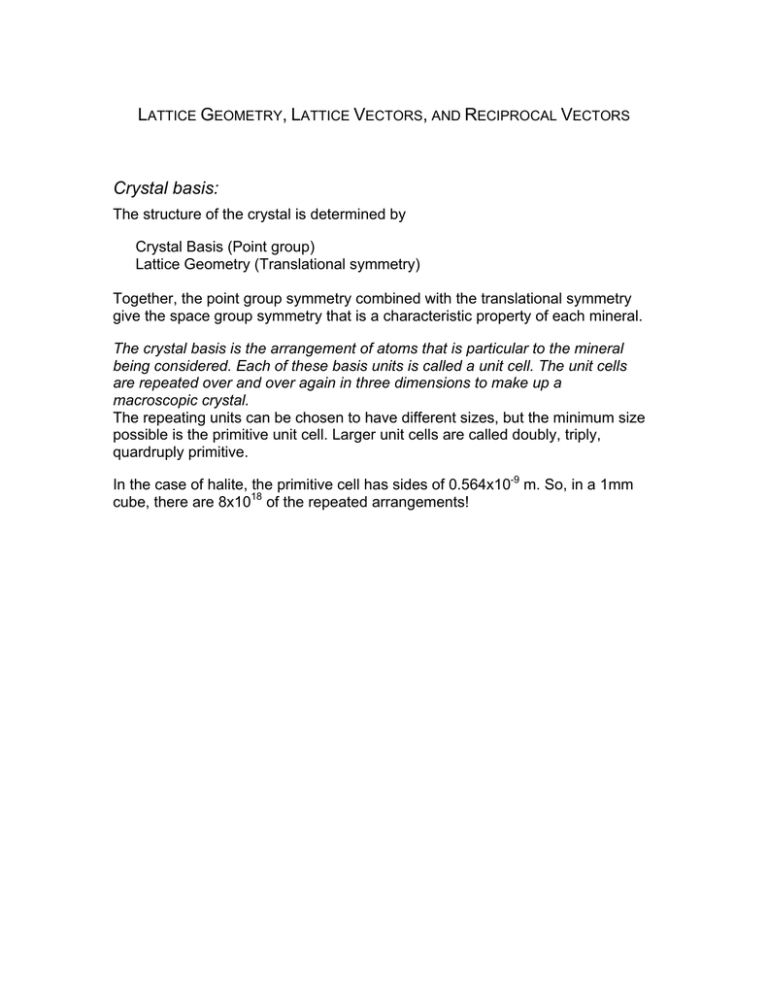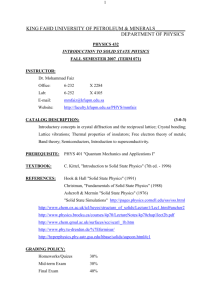L G , L V
advertisement

LATTICE GEOMETRY, LATTICE VECTORS, AND RECIPROCAL VECTORS Crystal basis: The structure of the crystal is determined by Crystal Basis (Point group) Lattice Geometry (Translational symmetry) Together, the point group symmetry combined with the translational symmetry give the space group symmetry that is a characteristic property of each mineral. The crystal basis is the arrangement of atoms that is particular to the mineral being considered. Each of these basis units is called a unit cell. The unit cells are repeated over and over again in three dimensions to make up a macroscopic crystal. The repeating units can be chosen to have different sizes, but the minimum size possible is the primitive unit cell. Larger unit cells are called doubly, triply, quardruply primitive. In the case of halite, the primitive cell has sides of 0.564x10-9 m. So, in a 1mm cube, there are 8x1018 of the repeated arrangements! Lattice points and vectors: Every point within the primitive unit cell is unique, but within the macroscopic crystal each point is repeated many times. Choose one point within the primitive unit cell and call it a lattice point. Lattice points: Point in a crystal with specific arrangement of atoms, reproduced many times in the crystal The translational part of the repetitions in the crystal is given by the lattice vectors. Choose a point within the repeated unit cell. It can be any point. Translate that point and all the surrounding atoms in the crystal basis by the repeat distance and direction, i.e., the lattice vector. Then the point is repeated, as are all the spatial relationships among the surrounding atoms. By choosing three non-coplanar vectors that correspond to the sides of the unit cell, one can reproduce a space-filling array of atoms. c ~ α Here are some things to know about lattice vectors: Lattice vectors connect two lattice points. 2. Any lattice point may be reached from any other by the vector addition of an integral number of lattice vectors. In general, the lattice vectors do not need to be 3. Non-integral combinations the same length, nor do they need to be normal to each other. By convention the angles, α, β, of the lattice vectors give and γ are related to the lattice vectors, a, b and the atomic positions of the c as shown. crystal basis. CsCl struc ture 4. Rational lattice directions connect one lattice point to another and are specified by integral components of the lattice vectors. They are denoted by a triple of numbers contained in brackets like Cl p ositio n is [1/2 1/2 1/2] [u v w] for a single direction or <u v w> for a set of symmetrically equivalent directions. 5. Fractional lattice indices are used to indicate atomic positions within the unit cell. 6. Miller Bravais notation, i.e. [u v t w], is sometimes used for the hexagonal system. The third index, t, is redundant since u+v+t=0. β ~a γ ~b 1. Crystal lattices: Meshes are 2d arrays of lattice points, Lattices are 3d arrays. Unit cells can be used to build the entire lattice. Primitive unit cells contain one lattice point only. The conventional primitive unit cell has the shortest and most nearly equal lattice vectors bounding it. The crystal basis is defined by the type, number, and arrangement of atoms inside the unit cell. Lattice coordinates are given by specifying the position of a point using a combination of lattice vectors. Fractional components indicate a position inside the unit cell and could be used, for example, to specify the positions of the atoms in the crystal basis. Integral components could indicate a direction or lattice vector. A direction with integral components is called a rational direction. Facts about unit cells: 7. 8. Unit cells are made by defining a set of coordinate axes composed of three non-coplanar, non-colinear lattice vectors. A primitive unit cell contains one lattice point, but may contain many atoms. Exercise: Graphite lattice mesh (After Kelly and Groves, Chapter 1). c d b e a f n m h i g j l k Choose atom “a” as a lattice point. Which other atoms are lattice points. Draw a few lattice vectors. How many lattice vectors are there? What are the shortest lattice vectors? Draw a bounding box with the shortest lattice vectors. This is the primitive cell. Solution to exercise: c d b e a f n m h i g j l k Crystal systems: The translational symmetry of all the 230 space groups can be grouped into 14 Bravais lattice systems: Seven of the 14 systems are primitive; they are triclinic, monoclinic, orthorhombic, trigonal (rhombohedral), tetragonal, hexagonal, and cubic. The remaining systems have similar shapes and angular relations, but are doubly or triply degenerate unit cells. Visual representations are given at the left. Cubic A fact about lattice systems: 9. P a a c Hexagonal a Trigonal a 120o a c 10. c a a a a P I Tetragonal 11. 12. c Orthorhombic b a Primitive � � 13. y a x Monoclinic c � � � b Triclinic The preferred unit cell is primitive, has lattice vectors as nearly equal in length as possible, and has an obtuse angle between two vectors, if possible. The preferred setting of the lattice often, but not always, has the symmetry element of greatest rank parallel with the c axis. (The monoclinic and trigonal-rhombohedral lattices are exceptions to this rule. The lattice system must have at least as great a symmetry as the point group symmetry, but it may also have more. The triclinic system is sometimes called the anorthic system because there are no angles that are orthogonal. The trigonal system may also be expressed as a triply degenerate hexagonal cell (see below). This setting is an example of point 10 above. There are several conventions for determining the choice of a,b, and c that reflect the symmetry of the crystal, and sometimes the conventions conflict. An example is the choice of the c axis in the monoclinic system. In this case, a prominent zone axis is often chosen as the axis (zone axes are defined below). Table: The seven crystal systems[After Whittaker, 1981pp. 24] Crystal system Cell Shape Cell axes Triclinic General parallelepiped Monoclinic Right prism with parallelogram as base Rectangular parallelepiped a≠b≠c α ≠ β ≠ γ ≠ 90° a≠b≠c α = γ = 90° ≠ β Orthorhombic Tetragonal Square prism a≠b≠c α = β = γ = 90° a=b≠c Characteristic Symmetry1 Monad 2 1 diad 3 3 diads 3 1 tetrad 7 1 triad 5 1 hexad 5 4 triads 7 # classes α = β = γ = 90° a = b = c α = β = γ ≠ 90° a=b≠c Trigonal (Rhomohedral) Cube deformed along one diagonal Hexagonal Prism on a 60° paralleogram α = β = 90°; γ = 120° Cube a = b = c Cubic α = β = γ = 90° 1 The characteristic symmetery is the minimum required to assign a crystal to a particular system. More symmetry than this is possible up to the “symmetry of shape of the cell”; hence the various different crystal classes in each system. Special case: Hexagonal system and Miller-Bravais Indices a2 Hexagonal lattice vectors are equal and at 120° to each other. The third axis extends out of the board [001] Can define a fourth lattice vector at 120° to the other two in the plane perpendicular to c. a3 a1 Can define a set of indices [u v t w] t is redundant since ua1+v a2=-t a3 Result numbers are called the Miller-Bravais indices Complication is tolerated because the relation between symmetrical directions and planes is more readily apparent. Word about Relation between Rhombohedral and Hexagonal lattices. Two lattices are related: rhombohedral is a primitive unit cell in a degenerate hexagonal cell By stacking a hexagonal mesh in the BA order, we can construct a triply degenerate hexagonal cell. An example of this sort of chicanery is the rhombohedral and trigonal lattices of calcite. c axis in hexagonal system is parallel to three fold Re la tionsh ip o f He xa g o na l a nd Trig o n a l a Hexa g o na l (Mille r-Bra va is La ttic e s) c a2 a1 a1 a3 Projec tion on (0001) Projec tion on (0110) c [1210] a2 a3 [1120] a1 [2110] SUMMARY Lattices and lattice directions: 1. Lattice points: Point in a crystal with specific arrangement of atoms, reproduced many times in a macroscopic crystal. The choice of the lattice point within the unit cell is arbitrary. 2. Crystal basis: Arrangement of atoms within the unit cell. 3. Lattice vectors connect two lattice points. Primitive lattice vectors are the shortest lattice vectors possible. Three of them span the lattice space. All other lattice vectors can be expressed as a set of three indices that tell the indices of the vector sum that reproduces a particular lattice vector. The indices are integral for lattice vectors and are non-integral for points within the unit cell. Square brackets are used for a particular direction and carets are used for all equivalent directions. [x y z] and <x y z>. Negative indices are given as x . 4. Unit cells are the space limited by a parallelepiped with edges that are three, non-coplanar lattice vectors. The primitive unit cell contains only one lattice point. The preferred primitive unit cell contains one lattice point and has the shortest lattice vectors that are nearly equal. The lattice vectors are chosen to have an obtuse angle between them, if possible. The preferred setting often, but not always, has the symmetry of greatest rank parallel with the c axis. (The monoclinic and trigonalrhombohedral lattices are exceptions. 5. Miller-Bravais notation is sometimes used for the hexagonal system, i.e. [u v t w]. Because only two of the u v and t are needed to span the basal plane, the third index is redundant and is given by u+v+t=0. BIBLIOGRAPHY: Bloss, F.D., Crystallography and Crystal Chemistry: An Introduction, 543 pp., Mineralogical Society of America, Washington, DC, 1994. Kelly, A., and G.W. Groves, Crystallography and Crystal Defects, 428 pp., Addison Wesley, N. Y., 1970. Whittaker, E.J.W., Crystallography: An introduction for Earth Science (and other solid-state) students, 254 pp. pp., Pergamon Press, Oxford, 1981.






